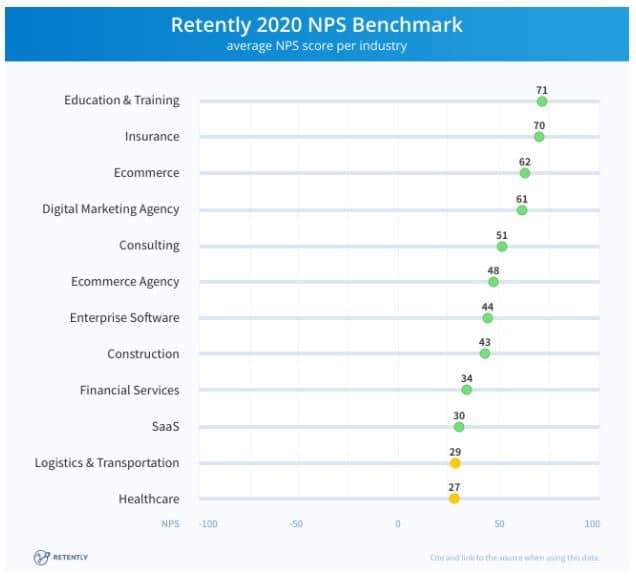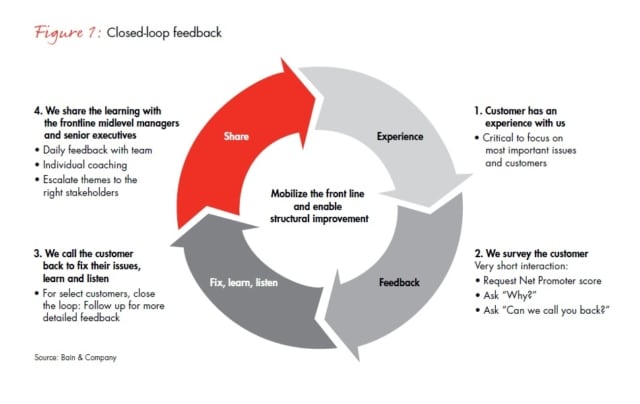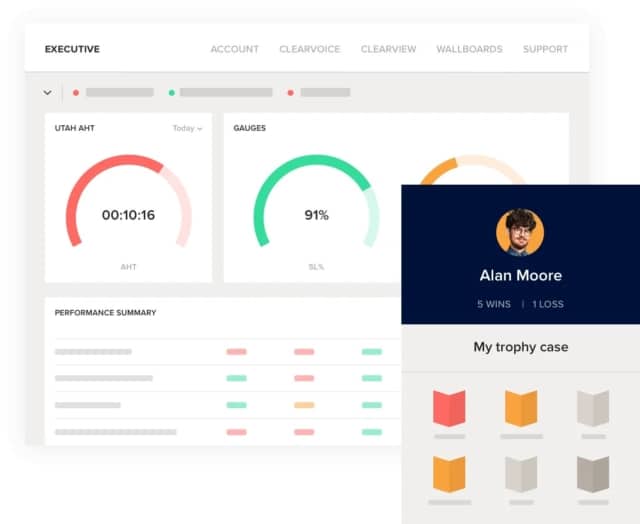Good customer service should be the foundation of every business. Happy customers tend to become returning customers, and returning customers mean more sales.
However, for some businesses, managing customer satisfaction can be tough. That’s where your Net Promoter Score (NPS) comes in.
The aim of an NPS survey is simple – you ask whether your customers are likely to recommend you to a friend. The information you can gain from this single question opens up a world of possibility when it comes to customer analytics and improving your customer service. Let’s take a look at what a Net Promoter Score is, how to calculate it, and what it can do for your business.
What is the Net Promoter Score?
A Net Promoter Score (NPS) is a way of measuring customer satisfaction. This metric is useful when you want a deeper insight into how a customer feels about your business. It was created by management consultant Fred Reichheld of Bain & Company in collaboration with Satmetrix Systems. Since 2003, organisations have used this tool to measure and manage their customer loyalty.
Customers answer simple questions on the point scale of 0-10. 0 being extremely unlikely, and 10 being extremely likely. Crucially, survey respondents are asked the ultimate question: How likely are you to recommend a company/brand/ this product to a friend/colleague/relative?
There is also an Employee Net Promoter Score (ENPS) that can be used to rate employee satisfaction in a similar fashion.
Calculating your Net Promoter Score
To calculate your NPS score, you need to group your respondents as follows:
- The promoters (9 and 10): These are loyal customers who engage with your brand. They are the customers that will continue to buy your products and support your brand, increasing growth and customer retention. As the name suggests, they will actively promote your brand to others.
- The passives (7 and 8): These customers may like some of your products, but they’re not dedicated to you. If a competitor offers a similar product, they could be swayed to shop elsewhere. They’re unlikely to actively talk about you, though they do hold favourable views about your business.
- The detractors (0 to 6): These are unhappy customers. They may have had a bad experience with your brand in terms of customer service, or they may be dissatisfied with your products. Not only are you at risk of losing them, but they’re also likely to give negative word-of-mouth feedback to their peers.
After grouping the responses, subtract the percentage of ‘detractors’ from the percentage of ‘promoters’. This will give you your Net Promoter Score.

There are a variety of ways to use this data. You might want to focus on geographical regions, age groups, or people who have bought a particular product. For example, if you’re interested to know what people in London think about your stores, you should only look at the participants from that region when analysing your score.
Of course, this score isn’t final. You can track your customer’s opinions on a regular basis to see how they feel about your brand, and if their loyalty remains. Checking your NPS score quarterly can give you a good idea of how your brand is doing, and whether any changes you make are working.
What’s the average Net Promoter Score?
The NPS survey technique is used by two-thirds of the fortune 1000. So, what’s the average Net Promoter Score? Well, benchmarking an NPS score is no easy feat, simply because there are a lot of different factors to consider. It’s important to note that the average score differs from industry to industry.
This graph shows the average for each sector in 2020:

As you can see at the top, the average score for education and training is 71. In comparison, at the bottom is healthcare with 27. Let’s say you’re a construction company. Your score might be 50 – and you might think that sounds low compared to the 62 you see eCommerce brands have. However, when you look at the benchmark for this particular industry (43), it’s clear you’re above average.
Why Is NPS Important?
Your NPS score is important because it provides insights into consumer behavior. This allows your business to do the following:
Highlights areas you can improve
First and foremost, it provides invaluable feedback from customers. Using this information, you’re able to see the areas you can improve in order to increase customer satisfaction.
One of the key benefits of the NPS is that you can see precisely how satisfied your customers are. And, with further survey questions, why that is. This helps you make better-informed decisions on how to keep them happy, based on what your respondents are telling you. For example, if they say they like how you put a ‘quote of the day’ card in with your packaging, you know to do this for more customers.
This is at the heart of what the NPS survey is all about. It’s a great tool for improving your business practices and monitoring the response. By regularly checking your NPS score, you can ensure the changes you’re making are working, and respond accordingly.
Additionally, this gives you a way to compare yourself to competitors – is their NPS score as high as yours? And why would your customers choose your competitor over you? You can include questions such as this in your NPS survey.
Allows you to prioritise detractors
Detractors are the group of people that are dissatisfied with your brand. They’re the ones who responded with a score of 0-6. 85% of consumers churn because of poor service that could have been prevented. Focusing on them and fixing their concerns could mean they stick with you, instead of choosing a competitor.
This is important when it comes to your bottom line. Follow-up on their survey answers with a new series of questions, specifically asking why they responded in the way they did. When customers feel like they’re being listened to and valued, they’re more likely to engage with the brand – especially if their issue is fixable.

It helps employees
If you share your NPS data with your employees, they will see a direct impact on their customer service skills. If your score is high, they’ll notice that their hard work is paying off! Similarly, if your NPS score is on the lower side of the scale, employees may need further training in customer service.
It measures loyalty
Critically, the net promoter system measures loyalty. Loyalty is good for business – it’s cheaper and often more effective to keep hold of existing customers than to entice new customers. The information your customers offer will help you plan ahead. You can compile a strategy to retain the detractors, and nurture the passives.
Creates more advocates
The customers that scored you a 9 or 10 are your advocates. They’re the ones telling their friends about your products and recommending your brand. This is crucial when you’re trying to grow your business and brand identity. Your NPS will give you a good idea of how to increase these advocates, and how to turn your passive customers into promoters based on their feedback response.
For instance, if a passive responder says they’d shop with you more often if you offered free delivery, you can try this and offer free delivery when the customer’s order totals over £30. In the next NPS survey you conduct, you may find those passive responders have turned into promoters, simply based on you acting on their constructive feedback.
What is an NPS Survey?
Although the question, ‘how likely are you to recommend the brand to a friend?’ is often regarded as the most important of the NPS survey questions, some businesses may wish to delve deeper. With a full NPS survey, you can ask customers detailed questions to understand their thoughts about the business.

How do you create an NPS survey?
You can use a template to create an NPS survey, but often you’re able to access more data when you create it yourself. Whether you use survey software, collate email responses or a custom tool, it’s worth merging the data into your other solutions. For instance, you can integrate the results with RingCentral software to sync your scores and data. This will allow you to keep track of your customers, and manage the interactions your customer service team has with them.
Once you have your platform ready, it’s time to think about the type of questions you ask, and who you will ask. For example, will you be focusing on customers based on their geographical location or their demographic? NPS surveys are usually sent out via email so you can reach customers no matter where they are. In order to encourage more responses, you can offer customers rewards for taking part, such as a 10% discount code for their next order.
NPS survey questions (Examples)
Here are some ways to word your NPS survey question:
- On a scale of 0-10, how likely are you to recommend our brand to your friends and family?
- Now that you’ve tried our product, on a scale of 0-10 how likely are you to recommend it to a colleague?
- How likely are you to recommend (product name) to a friend or colleague?
Follow-up question examples
- What can we do to make your experience with us better?
- What was the reason for your score?
- What did we do well?
- What features do you value/use the most?
- What do you least like about (product name)?
Transactional vs relational NPS programmes
A transactional NPS programme aims to understand the customer satisfaction level based on a specific level or stage of the customer journey. The feedback from a transactional NPS provides practical, specific feedback about an interaction such as a call from the customer contact centre, purchasing through a website, or product delivery.
Relational NPS programmes, on the other hand, aim to gauge a customer’s overall thoughts of the brand, not necessarily about one specific area. Using both of these models together allows you to see how good your overall performance is, but they can also be used independently.
When to use transactional NPS
A business should use the transactional NPS survey if they:
- Have just launched a specific product
- Want to identify specific weaknesses in the customer experience process
- Want to create different metrics for different teams
- Are an ecommerce site looking for insights on a transactional level
When to use relational NPS
A business should use the relational NPS survey if they:
- Want to gauge their overall brand health
- Want to NPS benchmark against their existing internal data
- Are trying to better understand customer loyalty
How to use NPS to grow your business
Businesses across the globe are already utilising NPS for growth. Here are some of the ways you can do the same:
Identify the risk of churn
Every business is bound to have some detractors. Some more than others. Look at this as an opportunity to improve, to reconnect with those who feel let down by you. After all, they were interested enough to buy your product in the first instance, so at some point they liked what you were offering. So, where did it all go wrong? Understand the touchpoints where you may have lost them.
Feedback loops can help with this. The image below shows the closed-loop feedback you can build from your NPS question. It features the cycle from when the customer first has an experience with you, to them offering you feedback (where your NPS survey comes in). Taking that feedback on board, you make necessary changes ready for the next customer’s improved experience.

Using data from your NPS survey, you can focus on detractors and identify which customers are likely to stop buying from you. You can then segment these customers, and target them with another more personalised survey. This should include questions about why they feel like your brand has room for improvement, and what you can do in order to change their minds. By keeping onto those customers, you’re boosting your business growth – did you know that increasing customer retention by just 5% results in a minimum 25% increase in profit?
Improve marketing techniques
You can use your NPS survey to boost referral marketing. When you have a group of customers who are key drivers for growth and telling you they love your product, you want them to tell the world. Take advantage of this through case studies, testimonials, and online reviews. Few marketing methods sell a product better than a real customer endorsing your brand. Knowing who your promoters are will let you improve this area of marketing.
Track customer analytics
Grow your business by tracking analytics. Respondents may say that your frontline employee customer service needs improving. For example, maybe they don’t appreciate long wait times on hold, or perhaps they’re not getting a response from you on your social media channels.

Once you have this information, you need to analyse it. Using tools like RingCentral can provide you with real-time analytics, including tracking data from your CRM and other sources. You can use this information to establish where you went wrong, and work with your team on how you’re going to improve it.
Will you be using an NPS survey in the future?
It’s clear to see that an NPS score can help a business to understand their customers’ wants and needs, whether they are happy or unhappy customers. And even though the criticism from those unhappy customers may be harsh, it’s worth diving into when you can utilise it to grow your business.
It’s also useful to look into customer service analytics. Tools such as RingCentral are a great help for this, as you can gain further insights into the customer service being provided at your business’s contact centre. This is the place that customers call if they have a query or concern about your product or service. Looking into data from here alongside your NPS survey results can help you to gain some clarity as you analyse the areas you excel in, and those that need improvement.
Now that you’ve got a better idea of the Net Promoter Score and the benefits of conducting an NPS survey for your company, will you be incorporating them into your customer service practices?
Originally published May 05, 2021

